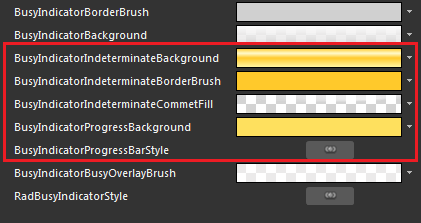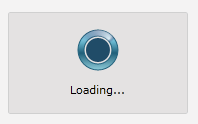Styling the RadProgressBar
Before reading this topic, you might find it useful to get familiar with the Template Structure of the RadBusyIndicator control.
The RadBusyIndicator exposes a ProgressBarStyle property which allows you to modify the control's progress bar default appearance.
You have two options:
Modify the default Style
To copy the default styles, load your project in Expression Blend and open the User Control that holds the RadBusyIndicator. In the 'Objects and Timeline' pane select the RadBusyIndicator you want to style. From the menu choose Object -> Edit Style -> Edit a Copy. You will be prompted for the name of the style and where to be placed.
If you choose to define the style in Application, it would be available for the entire application. This allows you to define a style only once and then reuse it where needed.
After clicking 'OK', Expression Blend will generate the default style of the RadBusyIndicator control in the Resources section of your User Control. The properties available for the style will be loaded in the 'Properties' pane and you will be able to modify their default values. You can also edit the generated XAML in the XAML View or in Visual Studio.
Here are the generated resources related to the RadProgressBar:

BusyIndicatorProgressBarStyle - represents the default style applied to the RadProgressBar control.
BusyIndicatorIndeterminateBackground - represents the brush applied to the indicator's outer donut.
BusyIndicatorIndeterminateBorderBrush - represents the brush applied to the indicator's outer donut's border.
BusyIndicatorIndeterminateCommetFill - represents the brush applied to the rolling comet.
BusyIndicatorProgressBackground - represents the brush applied to the inner circle of the RadBusyIndicator control.
Here is an example of the above resources modified:

Here is the result:

Create a custom ProgressBar Style
Read more about the RadProgressBar here.
When you choose to create a custom ProgressBarStyle you will lose the RadBusyIndicator's default template.
Here is a simple example of creating a custom style for your RadProgressBar:
Custom RadProgressBar Style
<Style x:Key="CustomProgressBarStyle" TargetType="telerik:RadProgressBar">
<Setter Property="Foreground" Value="#FF027DB8"/>
<Setter Property="Background" Value="#FFD2D5D8"/>
<Setter Property="BorderThickness" Value="1"/>
<Setter Property="Maximum" Value="100"/>
<Setter Property="IsTabStop" Value="False"/>
<Setter Property="BorderBrush">
<Setter.Value>
<LinearGradientBrush EndPoint=".5,1" StartPoint=".5,0">
<GradientStop Color="#FFAEB7BF" Offset="0"/>
<GradientStop Color="#FF919EA7" Offset="0.35"/>
<GradientStop Color="#FF7A8A99" Offset="0.35"/>
<GradientStop Color="#FF647480" Offset="1"/>
</LinearGradientBrush>
</Setter.Value>
</Setter>
<Setter Property="Margin" Value="0,0,0,-25"/>
</Style>
Use the ProgressBarStyle property to apply the style to the RadBusyIndicator:
Setting the ProgressBarStyle
<telerik:RadBusyIndicator ProgressBarStyle="{StaticResource CustomProgressBarStyle}" />
And the result is:
